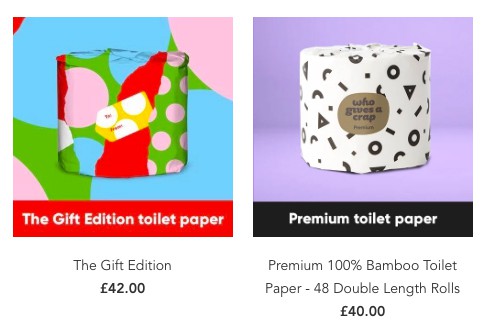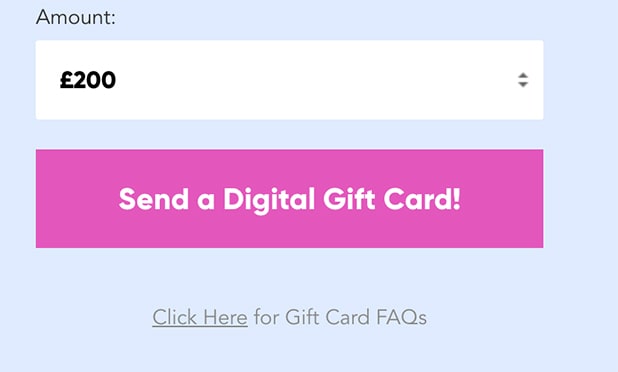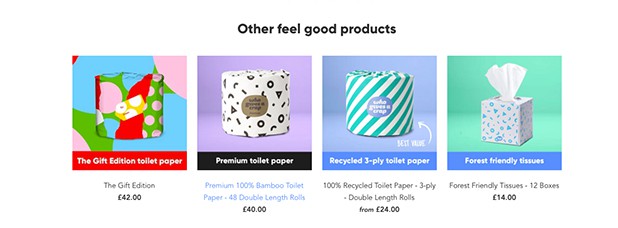We wanted to dive deep into a segment of the direct-to-consumer (DTC) industry most people haven’t thought about: toilet paper. Namely: the awesome brand, Who Gives a Crap.
Who gives a crap sell a range of premium toilet paper online to their customers. We wanted to reverse engineer its pricing strategy to better understand how a company was able to take a commodity product like toilet paper and turn it into a premium online product.
Whogivesacrap raised over $200,000 in funding and currently donates 50% of all profits to causes around the world that help build toilets for those in need.
In this post we’ll cover:
- Why premium pricing sets you apart from competitors
- How to use digital gift-cards to increase customer lifetime value (CLTV)
- The important branding detail that allows WGAC to charge more for their products
- The fool-proof refund strategy that keeps customers hungry for more
Let’s dive right into the e-commerce pricing teardown part 7,
Premium pricing
One of the things about direct to consumer brands is the issue of competition. They’re competing with household names and cheaper nameless brands.
In general, DTC products are priced higher than you’d find elsewhere. This trend stems across all industries within the space but isn’t without legitimate reasons.
DTC companies usually have a much stronger connection with their customers, whether that’s through their own sales and customer support channels or through their marketing and branding.

If someone suggested you pay £42 for toilet roll, you might question whether they were okay! Or perhaps you’d assume it was for a year’s supply.
Now what’s interesting is this DTC business only sells in bulk. For £40.00 you can buy 48 double-length rolls, or for £42 you can buy the “gift edition”.
Why is it then that people are happy and willing to buy so much in advance, instead of simply going to any supermarket or convenience store and buying it wherever they are.
In comparison, If we compare the cost of these 48 rolls to the leading supermarket, there’s a stark difference.

To buy an equivalent 48 rolls, you’d only pay £16.
So, now, not only do you need to buy it in bulk, but you also need to spend an additional £24. In many cases, premium pricing works well as the price of the product is artificially high to encourage favorable perceptions amongst buyers.
Premium pricing uses marketing, branding and price points to highlight the quality of a product to potential buyers. In terms of consumers, they see a high price point and perceive quality. This is the exact reason brands like Apple or Balenciaga are able to charge significantly more than their competitors for often, the same or similar products.
It’s a psychological pricing tactic that works best when marketing, branding and product perception all fall in line and work in unison.
Gift cards in the digital world
We’re used to physical gift cards – they’re what you buy for people when you’re not completely sure what to get for them but you know what stores they’d like.

The great thing about digital gift cards in e-commerce is that they not only offer your business new custom but increase your original customer’s lifetime value.
Think about it.
Person A shops at your store and spends, on average £200 a year.
They love your products and decide to buy a gift card for a friend so they can enjoy them too.
Now person A has spent an additional £200 on their friend.

Now, person A’s lifetime value has increased but you also have another customer ready to purchase your products.
Suppose person B loves the product and decides to continue buying after they’ve used the money on their gift card.
Now, you’ve marketed your products to 1 person but gained two new customers and increased overall lifetime value. Your customer acquisition costs decrease but the value of your customers’ increases.
According to statistics, 72% of customers spend more than the gift card amount while purchasing a product. When you receive a gift card, it doesn’t feel as though you’re spending your own money. Consumers are much more likely to opt for expensive items they wouldn’t normally choose, just because they’ll receive X amount off in the form of their gift card value.
But the benefits of using a digital gift card go beyond just monetary, it helps boost brand awareness too. If the person who receives the card has never heard of you, or never bought from you, they instantly receive insight into a potential new brand they might like. What’s more, if they like what you offer and your brand ethos, there’s a high potential they’ll continue to be your customer, even after the gift card has been used. They may even go as far as buying the same gift card for their own friends and family.
Now, as you remember, one crucial part of premium pricing is to leverage the perception of your products by aligning branding with price points. Offering gift cards allow you to do both at the same time.
Consistent branding
If there’s one thing we’ve come to expect with direct to consumer brands, it’s consistent branding. Consistent branding is a great way for people to not only establish themselves as a leader in their industry but differentiate themselves from their competition.
Doing so helps them charge higher prices. One way they combine branding with high prices is to showcase the work they do to give back.

You’ll notice, as a brand, they’re colorful and fun. They try to make the act of buying toilet paper an experience you actively think about, rather than an afterthought.
The best way they do that is to highlight their donations.

They have a page on their website that presents the donations made so far. As you can see, they’ve donated over £1,400,000. That’s 50% of total profit, which gives you an idea of total revenues from this amazing company.
In fact, their donation isn’t a simple marketing ploy to entice more customers, it’s embedded into their company. They regularly share impact updates that announce the latest donation amount.

They also make use of multimedia that shows they really do care about the causes they fight for. This consistent level of branding allows them to charge premium prices. Knowing how much they’ve been able to give back thanks to customers buying their products is a sure-fire way to demand such high prices.
Full refund
If you go to Who Gives a Crap website, you’ll see on most of the pages their offer of 100% money-back guarantee. What that means is, if for any reason you don’t love their products, you can send them back for a full refund.

Why does this work as a pricing strategy? Well, it brings us back to trust. We’ve already established that this brand sells a commodity product – at a premium price.
They’re at risk of people trying the product and thinking “it’s ok but not much better than anything else I’ve tried before”.
And so Who Gives a Crap have two options.
First, they need to ensure their product is the best it can be. If they market themselves as 10x better than the leading supermarket brand, they really need to ensure that it is.
Second, they need to show potential customers that they trust their own product. The fact they’re happy to offer a 100% money-back guarantee tells potential shoppers they trust the quality of their own products.
What’s important to note is returns come right out of your pocket. If your customer brings your product back, you offer them a full refund but you’re unable to re-use the product, you’ve essentially lost out on money. Think about your own profit margins and consider whether you can offer a 100% money-back guarantee or check whether doing so could potentially harm your bottom line overall.
As a pricing strategy, this technique works best for companies who have high margins and can afford to take the hit on their profit lines.
Final thoughts: Who gives a crap pricing strategy
In our e-commerce pricing teardown Part 7, we’ve looked into the four core strategies Who Gives a Crap use to market and sell their premium toilet roll, it’s time to start applying these techniques to your own store.
The direct-to-consumer e-commerce industry teaches us that even with commodity products, you can make a growing business.
Behemoths like Amazon, although are competitors, don’t stop you from capturing a unique valuable audience segment that you can use to grow your business.
So whether you’re going to raise your prices, offer digital gift cards, provide full refunds or work on your branding, find ways to make your products work for you.
What methods have you used from above? Leave a comment below.

Comments (2)
Aaron Starc
18.06.2020Well written blog. Though, it is quite old but you see more and more transparency you provide to your audiences about your way of doing business, or letting them who are the faces behind the brand. It builds a certain amount of trust and as we all know colours do provide a better chance in helping a customer make their decision.
Prisync Team
03.07.2020Thank you, Aaron!
Comments are closed.